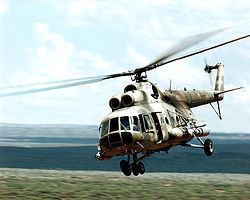Summary Shootdown Survivors 0 Date 20 November 1991 Destination Khojavend Flight origin Agdam | Fatalities 22 Aircraft name MI-8 Number of deaths 22 Survivor 0 | |
 | ||
Aircraft type Assault transport helicopter Similar 1991 Indonesian Air Force, Continental Express Flight 2574, Atlantic Southeast Airlines Fl, Nigeria Airways Flight 2120, Bill Graham helicopter | ||
The 1991 Azerbaijan MI-8 helicopter shootdown, also known as the Karakend tragedy in Azerbaijan, occurred on November 20, 1991, when an Azerbaijani MI-8 military helicopter, carrying a peacekeeping mission team consisting of 13 Azerbaijani government officials, 2 Russian and 1 Kazakhstani Ministry of Internal Affairs officials, 3 Azerbaijani journalists and 3 helicopter crew was shot down amidst heavy fighting near the Karakend village of Khojavend district in Nagorno-Karabakh. All 22 people (19 passengers and 3 crew) on board were killed in the crash.
Contents
Overview
In accordance with the Zheleznovodsk communique initiated by Boris Yeltsin and Nursultan Nazarbayev in the Russian city of Zheleznovodsk for the peaceful resolution of the Nagorno-Karabakh conflict and their subsequent shuttle diplomacy visit to the region on September 1991, officials from Russia and Kazakhstan were placed in the Nagorno-Karabakh Autonomous Oblast ("NKAO") for an observation mission. On the eve of the crash, the Armenian side refused to continue the peace talks with Azerbaijan until Azerbaijan re-opened the natural gas supply to Armenia, which it ceased on November 4. The team of observers along with representatives of Azerbaijani government were to fly from Agdam to Khojavend due to rising tension in the district.
Shootdown
Helicopter MI-8 with the peacekeeping team departed from Agdam with 22 people on board and was shot down en route by Armenian attack using a group of ZSU-23-4 Shilka and SA-6 missiles, killing everyone on board. The attack on the helicopter disrupted the ongoing peace talks.
Various conspiracy theories about the shoot down have since been in circulation, and are promoted by various political figures in Azerbaijan, who say the shoot down was a political assassination. Despite an absence of official investigation evidence, such theories are considered credible by a significant part of the Azerbaijani population.
Investigation
Initial reports by central state agency TASS claimed the helicopter flew into a fog and crashed into a hill. On November 21, the chairman of the crash investigation committee announced over TV that the helicopter was shot at by large caliber weapons and the weapons and video equipment was stolen from the site of the incident. At 6:30 PM, the same day, the deputy Chief of Command of Internal Troops of the Ministry for Internal Affairs of USSR, Vyacheslav Ponomarev left for Agdam. The Interior Ministry officials declared they would not pull out the internal troops detachments out of the district due to escalation of the conflict. The investigation committee was also to determine where the victims would be buried. However, because the area of the crash was soon captured by Armenian militants, the investigation was suspended and no one was indicted.
The investigation was initiated for claryfying the reasons of crash. The first version was transferred by TASS referring to the commander's special area of NKAO: helicopter exploded, sprung up on a rock in the fog. However, an investigation found holes in the fuselage consistent with the explosion of a rocket. Investigation Commission Chairman Adil Agayev said that the helicopter was shot down from the ground by a large-caliber weapons, video equipment and weapons from the crash site were kidnapped. Armenians denied any involvement, they were blamed immediately for the incident. In response to Agayev the deputies of the USSR from Armenia and Nagorno-Karabakh Zori Balayan, Victor Hambardzumyan, Henrik Igityan, Sos Sargsyan accused Central television of bias and hinted at the non-participation of Armenians to the crash. According to American researcher Michael P. Croissant, it is appeared to be an Armenian rocket attack.
Aftermath
After the public burial of the Azerbaijani victims in Baku on November 22, demonstrations began. The protestors demanded the Supreme Soviet and the chairman of Communist Party of Azerbaijan, Ayaz Mutalibov, to establish authority in Karabakh or resign from office. As a result, the Supreme Soviet called a special session on November 26 requesting to impose a martial law in the republic, withdrawing cadets and officers of Azerbaijani ethnicity from Soviet Army and ceasing all negotiations with Armenia. On November 27, the Supreme Soviet voted in favor of abolishing the autonomous status of NKAO and established direct rule over it. It also officially changed the name of Stepanakert to its pre-Soviet name Khankendi and re-arranged administrative division of the rayons in Nagorno-Karabakh area.
